Office Software Suite Upgrade Project Plan for BizOps Enterprises
VerifiedAdded on 2023/06/03
|17
|5213
|322
Project
AI Summary
This project plan outlines the upgrade of office software for BizOps Enterprises, a retail organization with 150 stores, seven warehouses, and a head office. The plan evaluates three options: maintaining the current open-source software, adopting proprietary software, and a combination of both. It addresses assumptions, software licensing, budgets, advantages, and disadvantages for each option. The project includes a survey of current requirements, recommendations, a selected option with a quotation, implementation strategies, a timeline, a consulting strategy, a training plan, project risk management, and key performance indicators. The goal is to improve the office administrative software system, enhance features, and improve user interfaces for 930 employees. The project also includes a training needs analysis and addresses the use of various office suite components such as word processors, spreadsheets, databases, and presentation modules, considering the different operating systems used by the employees. The plan aims to provide a comprehensive approach to the software upgrade, addressing the current challenges and potential improvements, and ultimately increasing the company's efficiency and productivity. The plan also details the deliverables, which include the software implementation, training employees, and more.
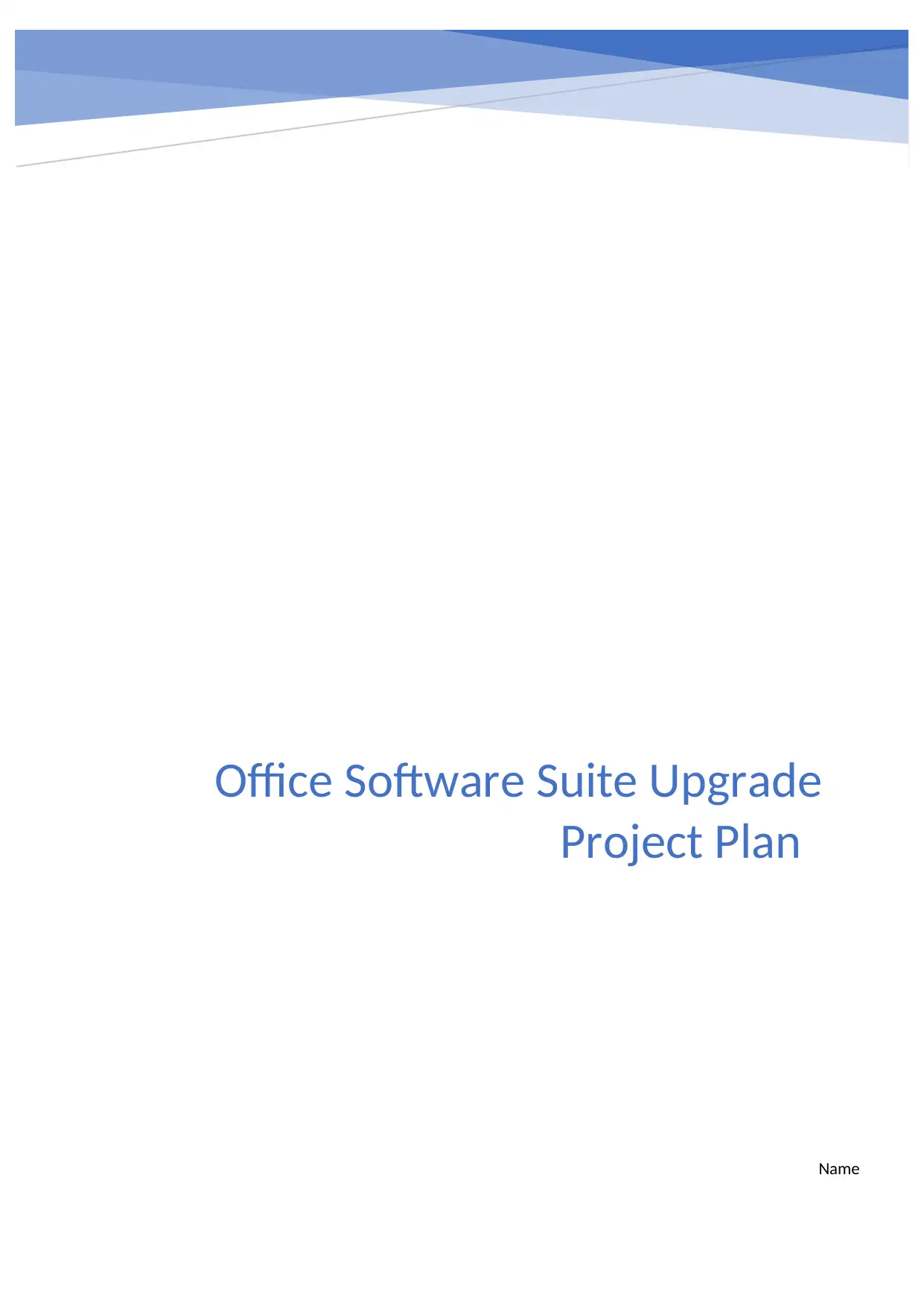
Office Software Suite Upgrade
Project Plan
Name
Project Plan
Name
Paraphrase This Document
Need a fresh take? Get an instant paraphrase of this document with our AI Paraphraser
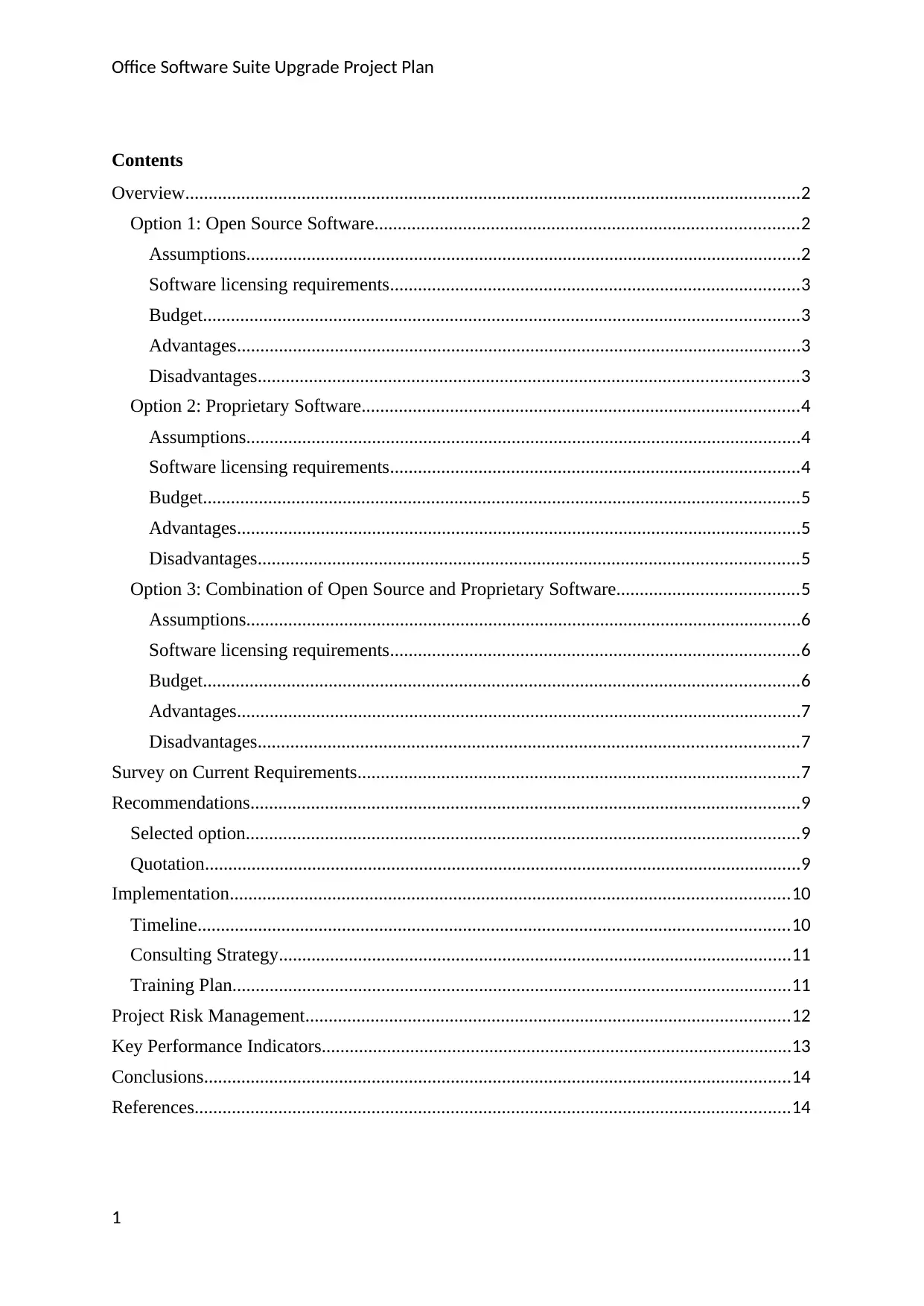
Office Software Suite Upgrade Project Plan
Contents
Overview....................................................................................................................................2
Option 1: Open Source Software...........................................................................................2
Assumptions.......................................................................................................................2
Software licensing requirements........................................................................................3
Budget................................................................................................................................3
Advantages.........................................................................................................................3
Disadvantages....................................................................................................................3
Option 2: Proprietary Software..............................................................................................4
Assumptions.......................................................................................................................4
Software licensing requirements........................................................................................4
Budget................................................................................................................................5
Advantages.........................................................................................................................5
Disadvantages....................................................................................................................5
Option 3: Combination of Open Source and Proprietary Software.......................................5
Assumptions.......................................................................................................................6
Software licensing requirements........................................................................................6
Budget................................................................................................................................6
Advantages.........................................................................................................................7
Disadvantages....................................................................................................................7
Survey on Current Requirements...............................................................................................7
Recommendations......................................................................................................................9
Selected option.......................................................................................................................9
Quotation................................................................................................................................9
Implementation........................................................................................................................10
Timeline...............................................................................................................................10
Consulting Strategy..............................................................................................................11
Training Plan........................................................................................................................11
Project Risk Management........................................................................................................12
Key Performance Indicators.....................................................................................................13
Conclusions..............................................................................................................................14
References................................................................................................................................14
1
Contents
Overview....................................................................................................................................2
Option 1: Open Source Software...........................................................................................2
Assumptions.......................................................................................................................2
Software licensing requirements........................................................................................3
Budget................................................................................................................................3
Advantages.........................................................................................................................3
Disadvantages....................................................................................................................3
Option 2: Proprietary Software..............................................................................................4
Assumptions.......................................................................................................................4
Software licensing requirements........................................................................................4
Budget................................................................................................................................5
Advantages.........................................................................................................................5
Disadvantages....................................................................................................................5
Option 3: Combination of Open Source and Proprietary Software.......................................5
Assumptions.......................................................................................................................6
Software licensing requirements........................................................................................6
Budget................................................................................................................................6
Advantages.........................................................................................................................7
Disadvantages....................................................................................................................7
Survey on Current Requirements...............................................................................................7
Recommendations......................................................................................................................9
Selected option.......................................................................................................................9
Quotation................................................................................................................................9
Implementation........................................................................................................................10
Timeline...............................................................................................................................10
Consulting Strategy..............................................................................................................11
Training Plan........................................................................................................................11
Project Risk Management........................................................................................................12
Key Performance Indicators.....................................................................................................13
Conclusions..............................................................................................................................14
References................................................................................................................................14
1
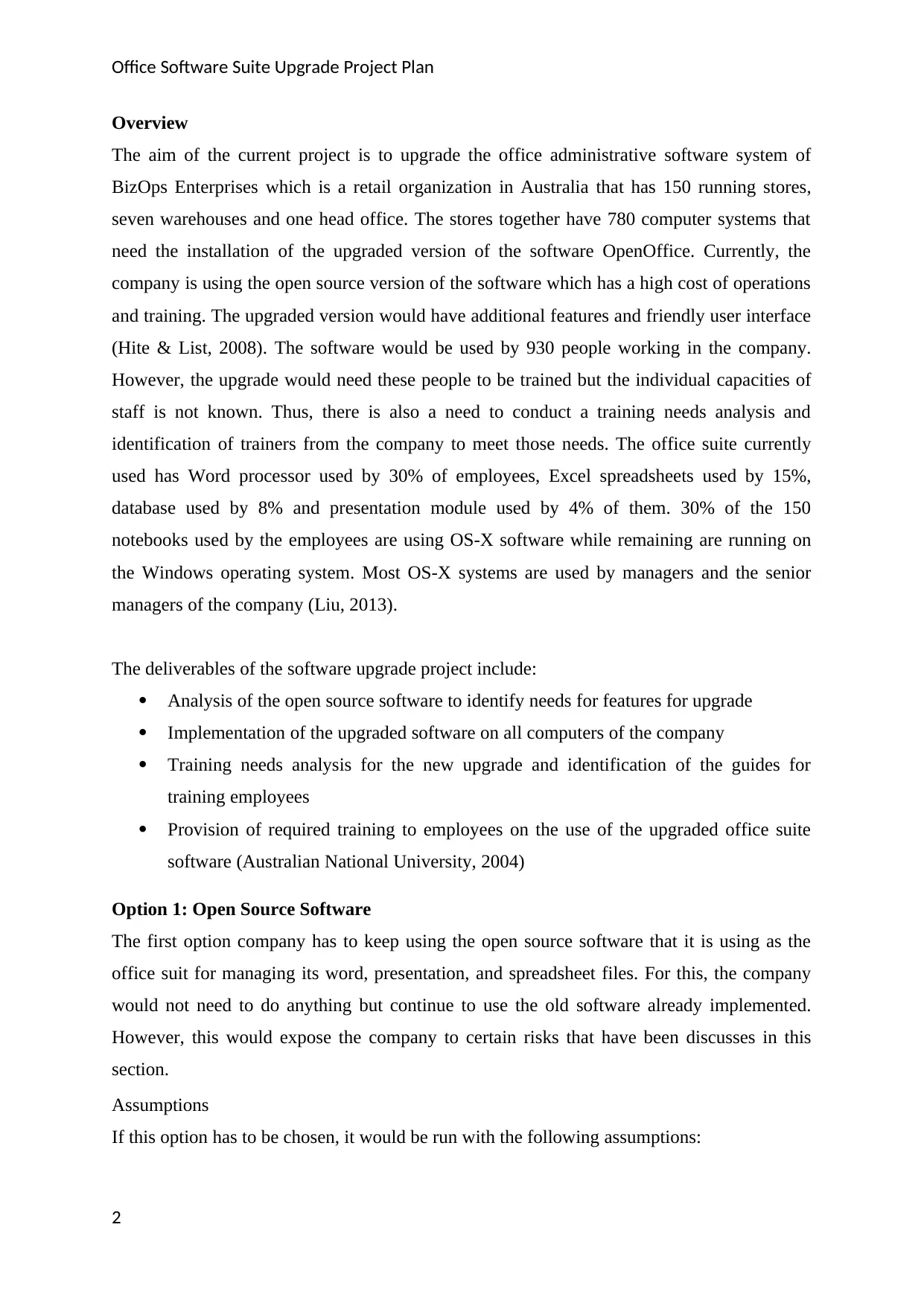
Office Software Suite Upgrade Project Plan
Overview
The aim of the current project is to upgrade the office administrative software system of
BizOps Enterprises which is a retail organization in Australia that has 150 running stores,
seven warehouses and one head office. The stores together have 780 computer systems that
need the installation of the upgraded version of the software OpenOffice. Currently, the
company is using the open source version of the software which has a high cost of operations
and training. The upgraded version would have additional features and friendly user interface
(Hite & List, 2008). The software would be used by 930 people working in the company.
However, the upgrade would need these people to be trained but the individual capacities of
staff is not known. Thus, there is also a need to conduct a training needs analysis and
identification of trainers from the company to meet those needs. The office suite currently
used has Word processor used by 30% of employees, Excel spreadsheets used by 15%,
database used by 8% and presentation module used by 4% of them. 30% of the 150
notebooks used by the employees are using OS-X software while remaining are running on
the Windows operating system. Most OS-X systems are used by managers and the senior
managers of the company (Liu, 2013).
The deliverables of the software upgrade project include:
Analysis of the open source software to identify needs for features for upgrade
Implementation of the upgraded software on all computers of the company
Training needs analysis for the new upgrade and identification of the guides for
training employees
Provision of required training to employees on the use of the upgraded office suite
software (Australian National University, 2004)
Option 1: Open Source Software
The first option company has to keep using the open source software that it is using as the
office suit for managing its word, presentation, and spreadsheet files. For this, the company
would not need to do anything but continue to use the old software already implemented.
However, this would expose the company to certain risks that have been discusses in this
section.
Assumptions
If this option has to be chosen, it would be run with the following assumptions:
2
Overview
The aim of the current project is to upgrade the office administrative software system of
BizOps Enterprises which is a retail organization in Australia that has 150 running stores,
seven warehouses and one head office. The stores together have 780 computer systems that
need the installation of the upgraded version of the software OpenOffice. Currently, the
company is using the open source version of the software which has a high cost of operations
and training. The upgraded version would have additional features and friendly user interface
(Hite & List, 2008). The software would be used by 930 people working in the company.
However, the upgrade would need these people to be trained but the individual capacities of
staff is not known. Thus, there is also a need to conduct a training needs analysis and
identification of trainers from the company to meet those needs. The office suite currently
used has Word processor used by 30% of employees, Excel spreadsheets used by 15%,
database used by 8% and presentation module used by 4% of them. 30% of the 150
notebooks used by the employees are using OS-X software while remaining are running on
the Windows operating system. Most OS-X systems are used by managers and the senior
managers of the company (Liu, 2013).
The deliverables of the software upgrade project include:
Analysis of the open source software to identify needs for features for upgrade
Implementation of the upgraded software on all computers of the company
Training needs analysis for the new upgrade and identification of the guides for
training employees
Provision of required training to employees on the use of the upgraded office suite
software (Australian National University, 2004)
Option 1: Open Source Software
The first option company has to keep using the open source software that it is using as the
office suit for managing its word, presentation, and spreadsheet files. For this, the company
would not need to do anything but continue to use the old software already implemented.
However, this would expose the company to certain risks that have been discusses in this
section.
Assumptions
If this option has to be chosen, it would be run with the following assumptions:
2
⊘ This is a preview!⊘
Do you want full access?
Subscribe today to unlock all pages.

Trusted by 1+ million students worldwide
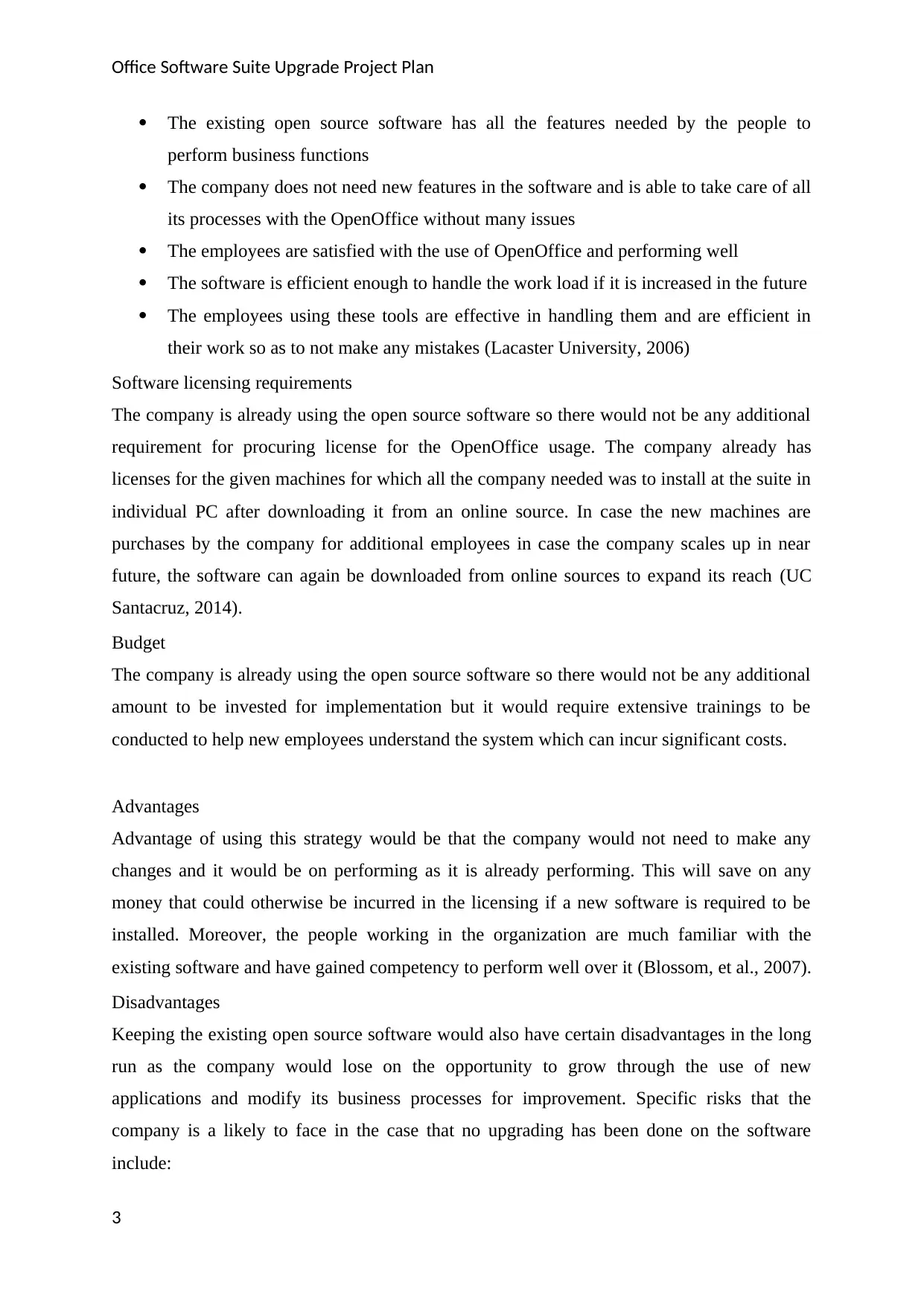
Office Software Suite Upgrade Project Plan
The existing open source software has all the features needed by the people to
perform business functions
The company does not need new features in the software and is able to take care of all
its processes with the OpenOffice without many issues
The employees are satisfied with the use of OpenOffice and performing well
The software is efficient enough to handle the work load if it is increased in the future
The employees using these tools are effective in handling them and are efficient in
their work so as to not make any mistakes (Lacaster University, 2006)
Software licensing requirements
The company is already using the open source software so there would not be any additional
requirement for procuring license for the OpenOffice usage. The company already has
licenses for the given machines for which all the company needed was to install at the suite in
individual PC after downloading it from an online source. In case the new machines are
purchases by the company for additional employees in case the company scales up in near
future, the software can again be downloaded from online sources to expand its reach (UC
Santacruz, 2014).
Budget
The company is already using the open source software so there would not be any additional
amount to be invested for implementation but it would require extensive trainings to be
conducted to help new employees understand the system which can incur significant costs.
Advantages
Advantage of using this strategy would be that the company would not need to make any
changes and it would be on performing as it is already performing. This will save on any
money that could otherwise be incurred in the licensing if a new software is required to be
installed. Moreover, the people working in the organization are much familiar with the
existing software and have gained competency to perform well over it (Blossom, et al., 2007).
Disadvantages
Keeping the existing open source software would also have certain disadvantages in the long
run as the company would lose on the opportunity to grow through the use of new
applications and modify its business processes for improvement. Specific risks that the
company is a likely to face in the case that no upgrading has been done on the software
include:
3
The existing open source software has all the features needed by the people to
perform business functions
The company does not need new features in the software and is able to take care of all
its processes with the OpenOffice without many issues
The employees are satisfied with the use of OpenOffice and performing well
The software is efficient enough to handle the work load if it is increased in the future
The employees using these tools are effective in handling them and are efficient in
their work so as to not make any mistakes (Lacaster University, 2006)
Software licensing requirements
The company is already using the open source software so there would not be any additional
requirement for procuring license for the OpenOffice usage. The company already has
licenses for the given machines for which all the company needed was to install at the suite in
individual PC after downloading it from an online source. In case the new machines are
purchases by the company for additional employees in case the company scales up in near
future, the software can again be downloaded from online sources to expand its reach (UC
Santacruz, 2014).
Budget
The company is already using the open source software so there would not be any additional
amount to be invested for implementation but it would require extensive trainings to be
conducted to help new employees understand the system which can incur significant costs.
Advantages
Advantage of using this strategy would be that the company would not need to make any
changes and it would be on performing as it is already performing. This will save on any
money that could otherwise be incurred in the licensing if a new software is required to be
installed. Moreover, the people working in the organization are much familiar with the
existing software and have gained competency to perform well over it (Blossom, et al., 2007).
Disadvantages
Keeping the existing open source software would also have certain disadvantages in the long
run as the company would lose on the opportunity to grow through the use of new
applications and modify its business processes for improvement. Specific risks that the
company is a likely to face in the case that no upgrading has been done on the software
include:
3
Paraphrase This Document
Need a fresh take? Get an instant paraphrase of this document with our AI Paraphraser
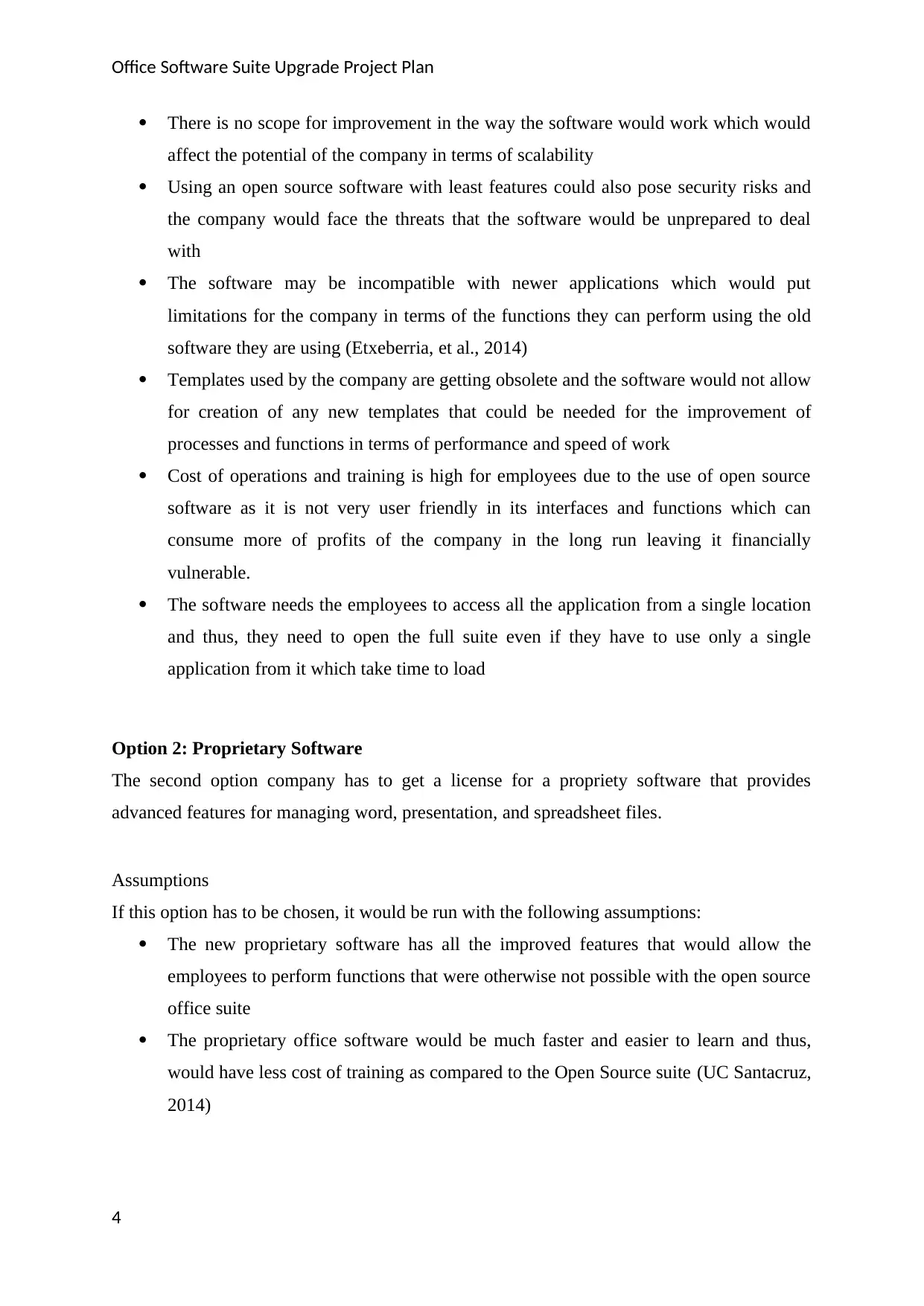
Office Software Suite Upgrade Project Plan
There is no scope for improvement in the way the software would work which would
affect the potential of the company in terms of scalability
Using an open source software with least features could also pose security risks and
the company would face the threats that the software would be unprepared to deal
with
The software may be incompatible with newer applications which would put
limitations for the company in terms of the functions they can perform using the old
software they are using (Etxeberria, et al., 2014)
Templates used by the company are getting obsolete and the software would not allow
for creation of any new templates that could be needed for the improvement of
processes and functions in terms of performance and speed of work
Cost of operations and training is high for employees due to the use of open source
software as it is not very user friendly in its interfaces and functions which can
consume more of profits of the company in the long run leaving it financially
vulnerable.
The software needs the employees to access all the application from a single location
and thus, they need to open the full suite even if they have to use only a single
application from it which take time to load
Option 2: Proprietary Software
The second option company has to get a license for a propriety software that provides
advanced features for managing word, presentation, and spreadsheet files.
Assumptions
If this option has to be chosen, it would be run with the following assumptions:
The new proprietary software has all the improved features that would allow the
employees to perform functions that were otherwise not possible with the open source
office suite
The proprietary office software would be much faster and easier to learn and thus,
would have less cost of training as compared to the Open Source suite (UC Santacruz,
2014)
4
There is no scope for improvement in the way the software would work which would
affect the potential of the company in terms of scalability
Using an open source software with least features could also pose security risks and
the company would face the threats that the software would be unprepared to deal
with
The software may be incompatible with newer applications which would put
limitations for the company in terms of the functions they can perform using the old
software they are using (Etxeberria, et al., 2014)
Templates used by the company are getting obsolete and the software would not allow
for creation of any new templates that could be needed for the improvement of
processes and functions in terms of performance and speed of work
Cost of operations and training is high for employees due to the use of open source
software as it is not very user friendly in its interfaces and functions which can
consume more of profits of the company in the long run leaving it financially
vulnerable.
The software needs the employees to access all the application from a single location
and thus, they need to open the full suite even if they have to use only a single
application from it which take time to load
Option 2: Proprietary Software
The second option company has to get a license for a propriety software that provides
advanced features for managing word, presentation, and spreadsheet files.
Assumptions
If this option has to be chosen, it would be run with the following assumptions:
The new proprietary software has all the improved features that would allow the
employees to perform functions that were otherwise not possible with the open source
office suite
The proprietary office software would be much faster and easier to learn and thus,
would have less cost of training as compared to the Open Source suite (UC Santacruz,
2014)
4
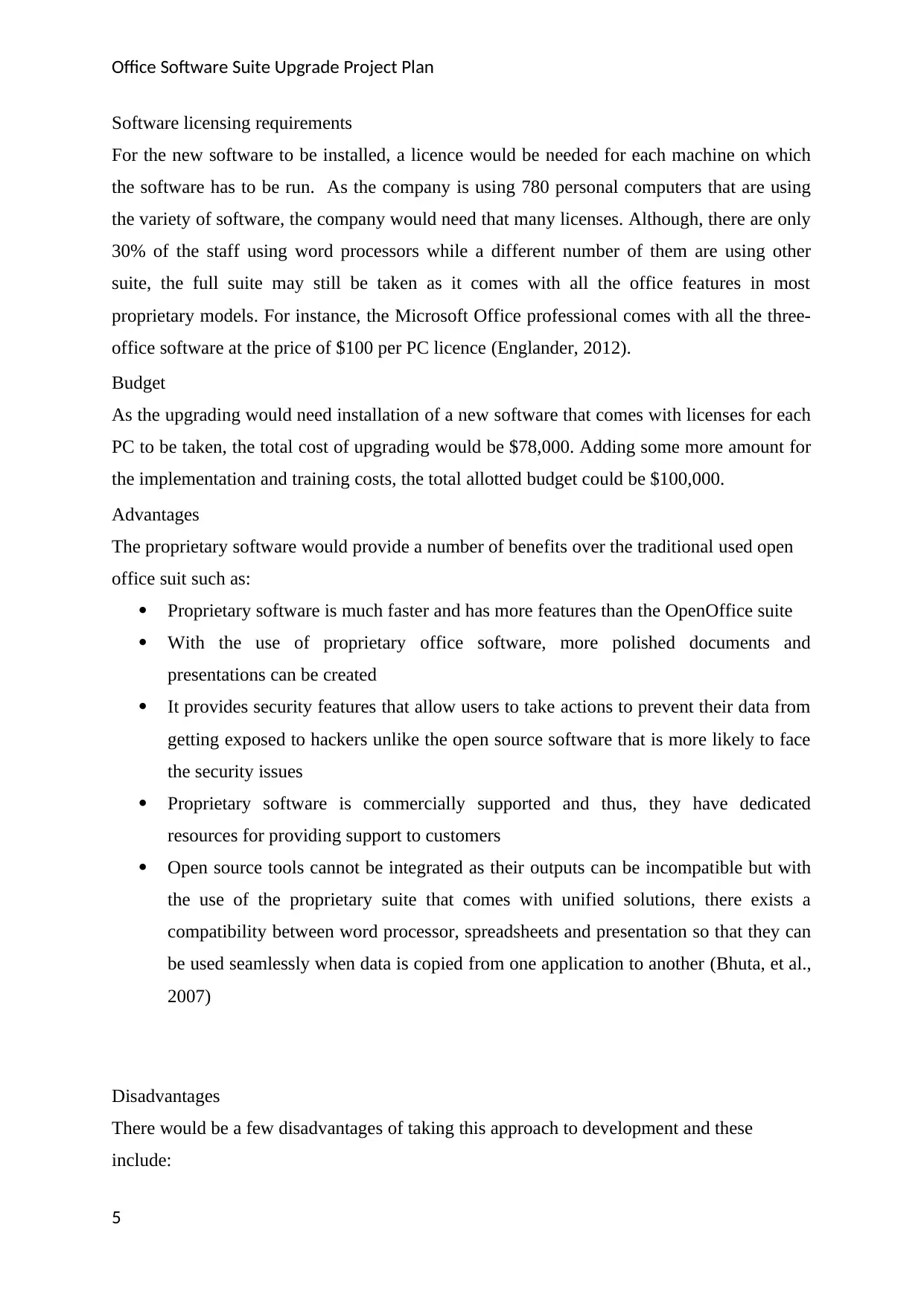
Office Software Suite Upgrade Project Plan
Software licensing requirements
For the new software to be installed, a licence would be needed for each machine on which
the software has to be run. As the company is using 780 personal computers that are using
the variety of software, the company would need that many licenses. Although, there are only
30% of the staff using word processors while a different number of them are using other
suite, the full suite may still be taken as it comes with all the office features in most
proprietary models. For instance, the Microsoft Office professional comes with all the three-
office software at the price of $100 per PC licence (Englander, 2012).
Budget
As the upgrading would need installation of a new software that comes with licenses for each
PC to be taken, the total cost of upgrading would be $78,000. Adding some more amount for
the implementation and training costs, the total allotted budget could be $100,000.
Advantages
The proprietary software would provide a number of benefits over the traditional used open
office suit such as:
Proprietary software is much faster and has more features than the OpenOffice suite
With the use of proprietary office software, more polished documents and
presentations can be created
It provides security features that allow users to take actions to prevent their data from
getting exposed to hackers unlike the open source software that is more likely to face
the security issues
Proprietary software is commercially supported and thus, they have dedicated
resources for providing support to customers
Open source tools cannot be integrated as their outputs can be incompatible but with
the use of the proprietary suite that comes with unified solutions, there exists a
compatibility between word processor, spreadsheets and presentation so that they can
be used seamlessly when data is copied from one application to another (Bhuta, et al.,
2007)
Disadvantages
There would be a few disadvantages of taking this approach to development and these
include:
5
Software licensing requirements
For the new software to be installed, a licence would be needed for each machine on which
the software has to be run. As the company is using 780 personal computers that are using
the variety of software, the company would need that many licenses. Although, there are only
30% of the staff using word processors while a different number of them are using other
suite, the full suite may still be taken as it comes with all the office features in most
proprietary models. For instance, the Microsoft Office professional comes with all the three-
office software at the price of $100 per PC licence (Englander, 2012).
Budget
As the upgrading would need installation of a new software that comes with licenses for each
PC to be taken, the total cost of upgrading would be $78,000. Adding some more amount for
the implementation and training costs, the total allotted budget could be $100,000.
Advantages
The proprietary software would provide a number of benefits over the traditional used open
office suit such as:
Proprietary software is much faster and has more features than the OpenOffice suite
With the use of proprietary office software, more polished documents and
presentations can be created
It provides security features that allow users to take actions to prevent their data from
getting exposed to hackers unlike the open source software that is more likely to face
the security issues
Proprietary software is commercially supported and thus, they have dedicated
resources for providing support to customers
Open source tools cannot be integrated as their outputs can be incompatible but with
the use of the proprietary suite that comes with unified solutions, there exists a
compatibility between word processor, spreadsheets and presentation so that they can
be used seamlessly when data is copied from one application to another (Bhuta, et al.,
2007)
Disadvantages
There would be a few disadvantages of taking this approach to development and these
include:
5
⊘ This is a preview!⊘
Do you want full access?
Subscribe today to unlock all pages.

Trusted by 1+ million students worldwide
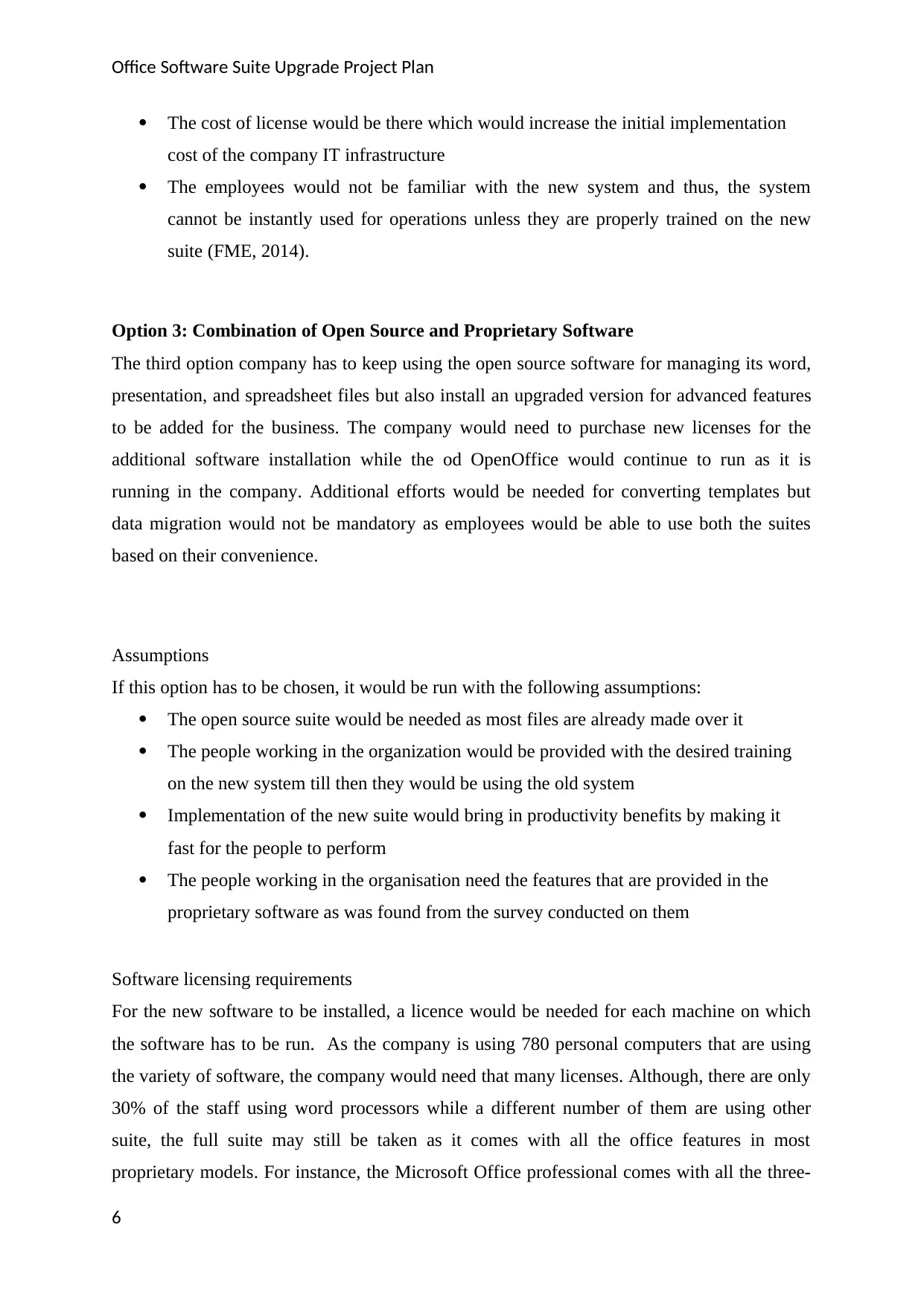
Office Software Suite Upgrade Project Plan
The cost of license would be there which would increase the initial implementation
cost of the company IT infrastructure
The employees would not be familiar with the new system and thus, the system
cannot be instantly used for operations unless they are properly trained on the new
suite (FME, 2014).
Option 3: Combination of Open Source and Proprietary Software
The third option company has to keep using the open source software for managing its word,
presentation, and spreadsheet files but also install an upgraded version for advanced features
to be added for the business. The company would need to purchase new licenses for the
additional software installation while the od OpenOffice would continue to run as it is
running in the company. Additional efforts would be needed for converting templates but
data migration would not be mandatory as employees would be able to use both the suites
based on their convenience.
Assumptions
If this option has to be chosen, it would be run with the following assumptions:
The open source suite would be needed as most files are already made over it
The people working in the organization would be provided with the desired training
on the new system till then they would be using the old system
Implementation of the new suite would bring in productivity benefits by making it
fast for the people to perform
The people working in the organisation need the features that are provided in the
proprietary software as was found from the survey conducted on them
Software licensing requirements
For the new software to be installed, a licence would be needed for each machine on which
the software has to be run. As the company is using 780 personal computers that are using
the variety of software, the company would need that many licenses. Although, there are only
30% of the staff using word processors while a different number of them are using other
suite, the full suite may still be taken as it comes with all the office features in most
proprietary models. For instance, the Microsoft Office professional comes with all the three-
6
The cost of license would be there which would increase the initial implementation
cost of the company IT infrastructure
The employees would not be familiar with the new system and thus, the system
cannot be instantly used for operations unless they are properly trained on the new
suite (FME, 2014).
Option 3: Combination of Open Source and Proprietary Software
The third option company has to keep using the open source software for managing its word,
presentation, and spreadsheet files but also install an upgraded version for advanced features
to be added for the business. The company would need to purchase new licenses for the
additional software installation while the od OpenOffice would continue to run as it is
running in the company. Additional efforts would be needed for converting templates but
data migration would not be mandatory as employees would be able to use both the suites
based on their convenience.
Assumptions
If this option has to be chosen, it would be run with the following assumptions:
The open source suite would be needed as most files are already made over it
The people working in the organization would be provided with the desired training
on the new system till then they would be using the old system
Implementation of the new suite would bring in productivity benefits by making it
fast for the people to perform
The people working in the organisation need the features that are provided in the
proprietary software as was found from the survey conducted on them
Software licensing requirements
For the new software to be installed, a licence would be needed for each machine on which
the software has to be run. As the company is using 780 personal computers that are using
the variety of software, the company would need that many licenses. Although, there are only
30% of the staff using word processors while a different number of them are using other
suite, the full suite may still be taken as it comes with all the office features in most
proprietary models. For instance, the Microsoft Office professional comes with all the three-
6
Paraphrase This Document
Need a fresh take? Get an instant paraphrase of this document with our AI Paraphraser
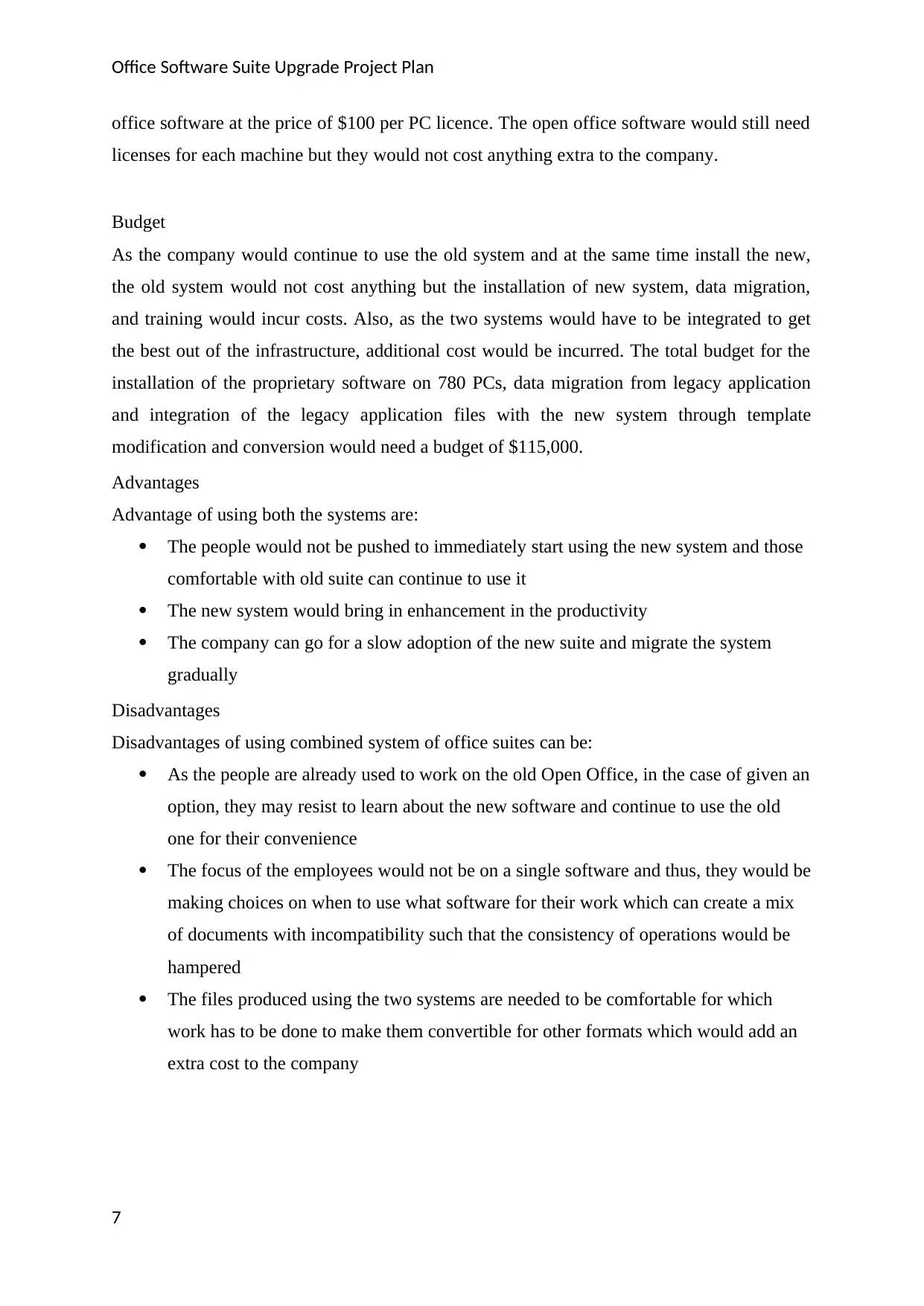
Office Software Suite Upgrade Project Plan
office software at the price of $100 per PC licence. The open office software would still need
licenses for each machine but they would not cost anything extra to the company.
Budget
As the company would continue to use the old system and at the same time install the new,
the old system would not cost anything but the installation of new system, data migration,
and training would incur costs. Also, as the two systems would have to be integrated to get
the best out of the infrastructure, additional cost would be incurred. The total budget for the
installation of the proprietary software on 780 PCs, data migration from legacy application
and integration of the legacy application files with the new system through template
modification and conversion would need a budget of $115,000.
Advantages
Advantage of using both the systems are:
The people would not be pushed to immediately start using the new system and those
comfortable with old suite can continue to use it
The new system would bring in enhancement in the productivity
The company can go for a slow adoption of the new suite and migrate the system
gradually
Disadvantages
Disadvantages of using combined system of office suites can be:
As the people are already used to work on the old Open Office, in the case of given an
option, they may resist to learn about the new software and continue to use the old
one for their convenience
The focus of the employees would not be on a single software and thus, they would be
making choices on when to use what software for their work which can create a mix
of documents with incompatibility such that the consistency of operations would be
hampered
The files produced using the two systems are needed to be comfortable for which
work has to be done to make them convertible for other formats which would add an
extra cost to the company
7
office software at the price of $100 per PC licence. The open office software would still need
licenses for each machine but they would not cost anything extra to the company.
Budget
As the company would continue to use the old system and at the same time install the new,
the old system would not cost anything but the installation of new system, data migration,
and training would incur costs. Also, as the two systems would have to be integrated to get
the best out of the infrastructure, additional cost would be incurred. The total budget for the
installation of the proprietary software on 780 PCs, data migration from legacy application
and integration of the legacy application files with the new system through template
modification and conversion would need a budget of $115,000.
Advantages
Advantage of using both the systems are:
The people would not be pushed to immediately start using the new system and those
comfortable with old suite can continue to use it
The new system would bring in enhancement in the productivity
The company can go for a slow adoption of the new suite and migrate the system
gradually
Disadvantages
Disadvantages of using combined system of office suites can be:
As the people are already used to work on the old Open Office, in the case of given an
option, they may resist to learn about the new software and continue to use the old
one for their convenience
The focus of the employees would not be on a single software and thus, they would be
making choices on when to use what software for their work which can create a mix
of documents with incompatibility such that the consistency of operations would be
hampered
The files produced using the two systems are needed to be comfortable for which
work has to be done to make them convertible for other formats which would add an
extra cost to the company
7
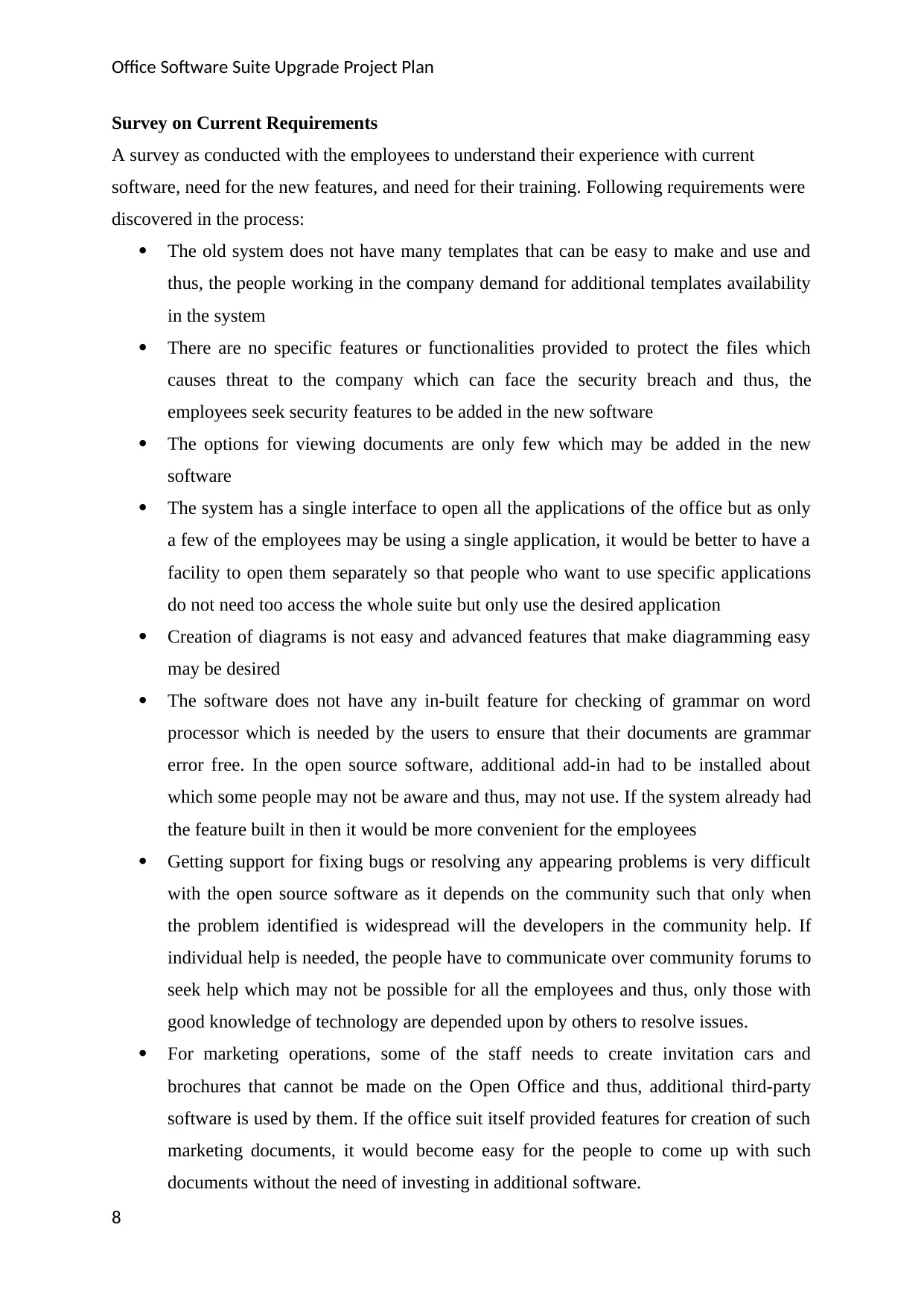
Office Software Suite Upgrade Project Plan
Survey on Current Requirements
A survey as conducted with the employees to understand their experience with current
software, need for the new features, and need for their training. Following requirements were
discovered in the process:
The old system does not have many templates that can be easy to make and use and
thus, the people working in the company demand for additional templates availability
in the system
There are no specific features or functionalities provided to protect the files which
causes threat to the company which can face the security breach and thus, the
employees seek security features to be added in the new software
The options for viewing documents are only few which may be added in the new
software
The system has a single interface to open all the applications of the office but as only
a few of the employees may be using a single application, it would be better to have a
facility to open them separately so that people who want to use specific applications
do not need too access the whole suite but only use the desired application
Creation of diagrams is not easy and advanced features that make diagramming easy
may be desired
The software does not have any in-built feature for checking of grammar on word
processor which is needed by the users to ensure that their documents are grammar
error free. In the open source software, additional add-in had to be installed about
which some people may not be aware and thus, may not use. If the system already had
the feature built in then it would be more convenient for the employees
Getting support for fixing bugs or resolving any appearing problems is very difficult
with the open source software as it depends on the community such that only when
the problem identified is widespread will the developers in the community help. If
individual help is needed, the people have to communicate over community forums to
seek help which may not be possible for all the employees and thus, only those with
good knowledge of technology are depended upon by others to resolve issues.
For marketing operations, some of the staff needs to create invitation cars and
brochures that cannot be made on the Open Office and thus, additional third-party
software is used by them. If the office suit itself provided features for creation of such
marketing documents, it would become easy for the people to come up with such
documents without the need of investing in additional software.
8
Survey on Current Requirements
A survey as conducted with the employees to understand their experience with current
software, need for the new features, and need for their training. Following requirements were
discovered in the process:
The old system does not have many templates that can be easy to make and use and
thus, the people working in the company demand for additional templates availability
in the system
There are no specific features or functionalities provided to protect the files which
causes threat to the company which can face the security breach and thus, the
employees seek security features to be added in the new software
The options for viewing documents are only few which may be added in the new
software
The system has a single interface to open all the applications of the office but as only
a few of the employees may be using a single application, it would be better to have a
facility to open them separately so that people who want to use specific applications
do not need too access the whole suite but only use the desired application
Creation of diagrams is not easy and advanced features that make diagramming easy
may be desired
The software does not have any in-built feature for checking of grammar on word
processor which is needed by the users to ensure that their documents are grammar
error free. In the open source software, additional add-in had to be installed about
which some people may not be aware and thus, may not use. If the system already had
the feature built in then it would be more convenient for the employees
Getting support for fixing bugs or resolving any appearing problems is very difficult
with the open source software as it depends on the community such that only when
the problem identified is widespread will the developers in the community help. If
individual help is needed, the people have to communicate over community forums to
seek help which may not be possible for all the employees and thus, only those with
good knowledge of technology are depended upon by others to resolve issues.
For marketing operations, some of the staff needs to create invitation cars and
brochures that cannot be made on the Open Office and thus, additional third-party
software is used by them. If the office suit itself provided features for creation of such
marketing documents, it would become easy for the people to come up with such
documents without the need of investing in additional software.
8
⊘ This is a preview!⊘
Do you want full access?
Subscribe today to unlock all pages.

Trusted by 1+ million students worldwide
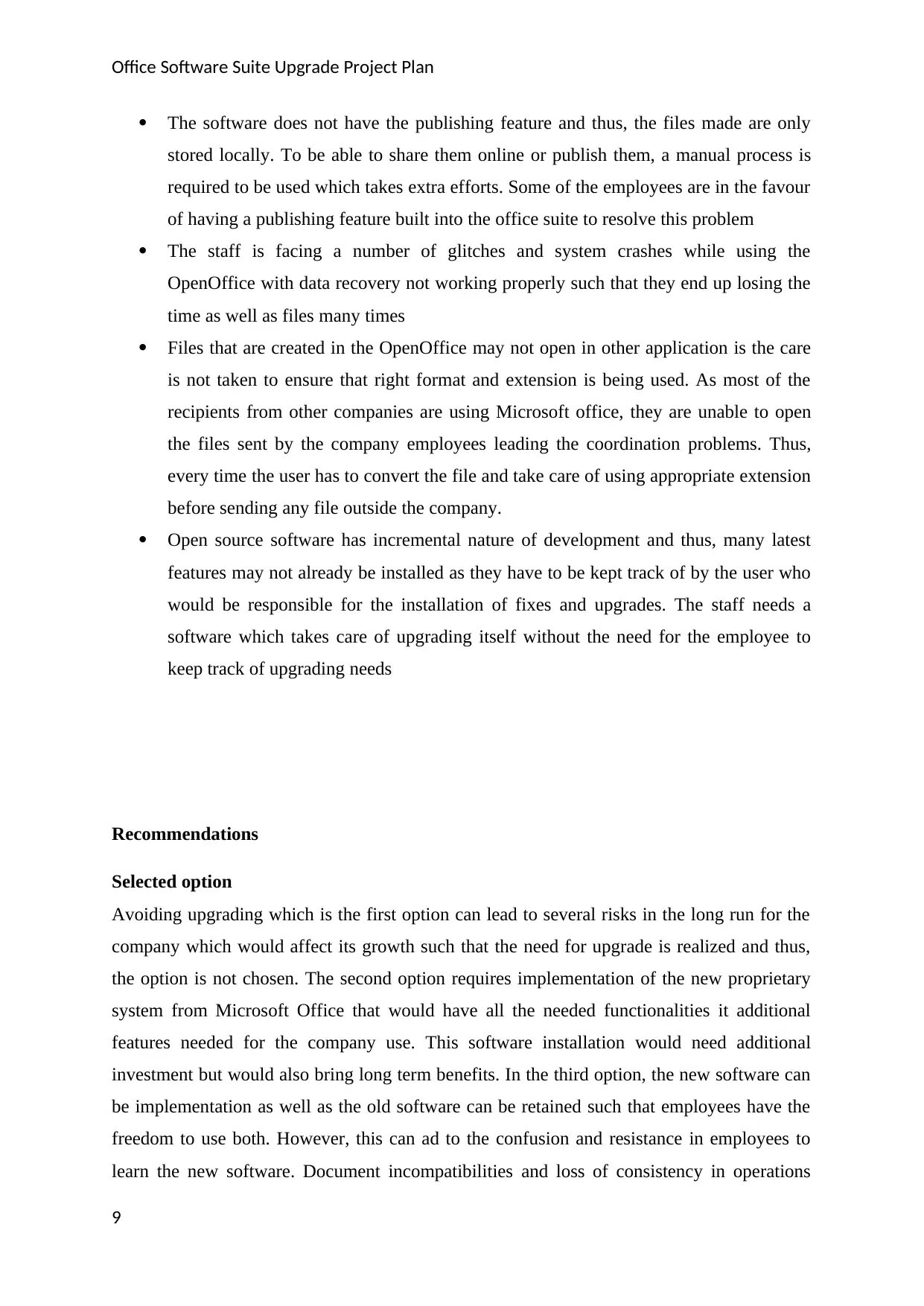
Office Software Suite Upgrade Project Plan
The software does not have the publishing feature and thus, the files made are only
stored locally. To be able to share them online or publish them, a manual process is
required to be used which takes extra efforts. Some of the employees are in the favour
of having a publishing feature built into the office suite to resolve this problem
The staff is facing a number of glitches and system crashes while using the
OpenOffice with data recovery not working properly such that they end up losing the
time as well as files many times
Files that are created in the OpenOffice may not open in other application is the care
is not taken to ensure that right format and extension is being used. As most of the
recipients from other companies are using Microsoft office, they are unable to open
the files sent by the company employees leading the coordination problems. Thus,
every time the user has to convert the file and take care of using appropriate extension
before sending any file outside the company.
Open source software has incremental nature of development and thus, many latest
features may not already be installed as they have to be kept track of by the user who
would be responsible for the installation of fixes and upgrades. The staff needs a
software which takes care of upgrading itself without the need for the employee to
keep track of upgrading needs
Recommendations
Selected option
Avoiding upgrading which is the first option can lead to several risks in the long run for the
company which would affect its growth such that the need for upgrade is realized and thus,
the option is not chosen. The second option requires implementation of the new proprietary
system from Microsoft Office that would have all the needed functionalities it additional
features needed for the company use. This software installation would need additional
investment but would also bring long term benefits. In the third option, the new software can
be implementation as well as the old software can be retained such that employees have the
freedom to use both. However, this can ad to the confusion and resistance in employees to
learn the new software. Document incompatibilities and loss of consistency in operations
9
The software does not have the publishing feature and thus, the files made are only
stored locally. To be able to share them online or publish them, a manual process is
required to be used which takes extra efforts. Some of the employees are in the favour
of having a publishing feature built into the office suite to resolve this problem
The staff is facing a number of glitches and system crashes while using the
OpenOffice with data recovery not working properly such that they end up losing the
time as well as files many times
Files that are created in the OpenOffice may not open in other application is the care
is not taken to ensure that right format and extension is being used. As most of the
recipients from other companies are using Microsoft office, they are unable to open
the files sent by the company employees leading the coordination problems. Thus,
every time the user has to convert the file and take care of using appropriate extension
before sending any file outside the company.
Open source software has incremental nature of development and thus, many latest
features may not already be installed as they have to be kept track of by the user who
would be responsible for the installation of fixes and upgrades. The staff needs a
software which takes care of upgrading itself without the need for the employee to
keep track of upgrading needs
Recommendations
Selected option
Avoiding upgrading which is the first option can lead to several risks in the long run for the
company which would affect its growth such that the need for upgrade is realized and thus,
the option is not chosen. The second option requires implementation of the new proprietary
system from Microsoft Office that would have all the needed functionalities it additional
features needed for the company use. This software installation would need additional
investment but would also bring long term benefits. In the third option, the new software can
be implementation as well as the old software can be retained such that employees have the
freedom to use both. However, this can ad to the confusion and resistance in employees to
learn the new software. Document incompatibilities and loss of consistency in operations
9
Paraphrase This Document
Need a fresh take? Get an instant paraphrase of this document with our AI Paraphraser
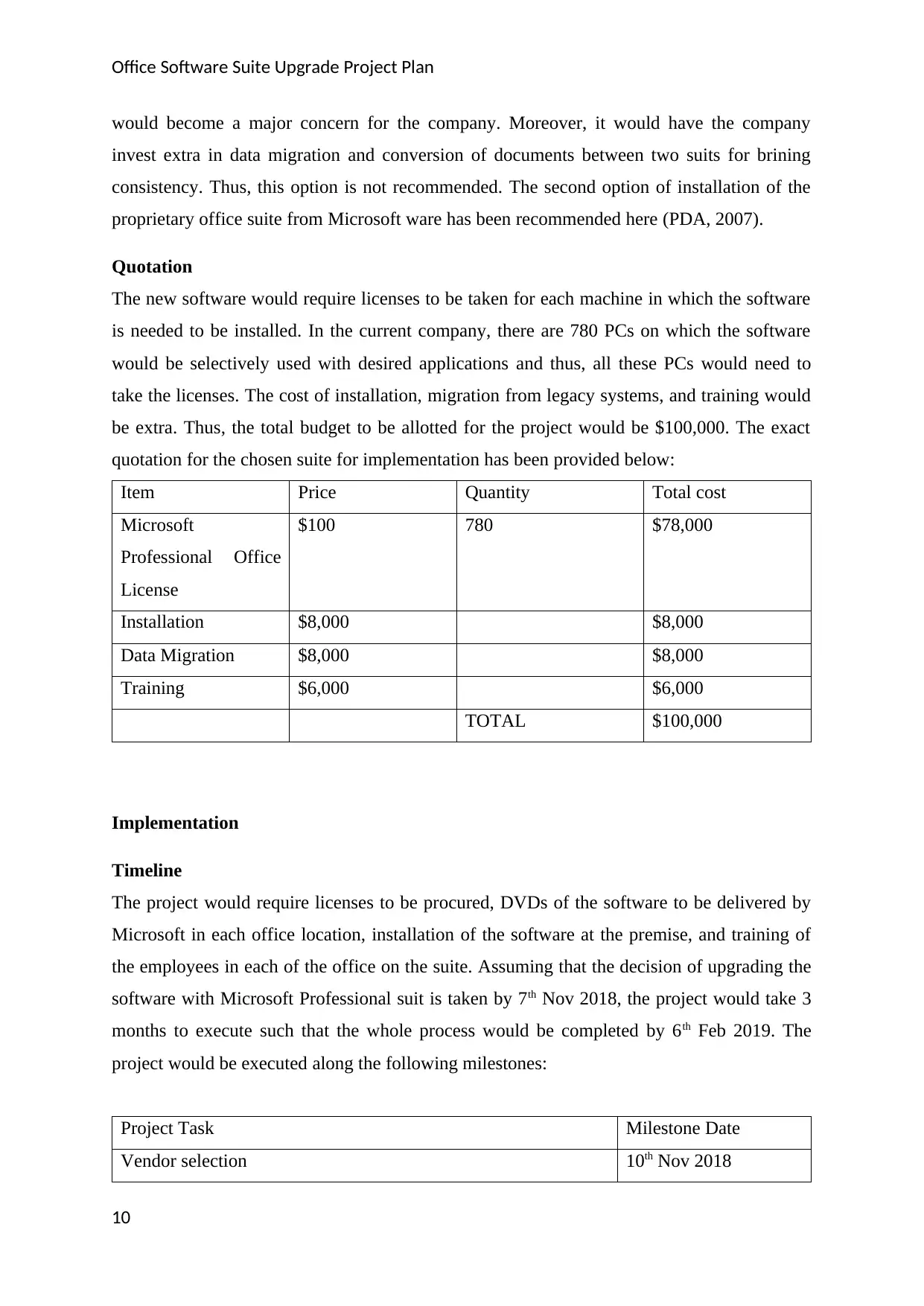
Office Software Suite Upgrade Project Plan
would become a major concern for the company. Moreover, it would have the company
invest extra in data migration and conversion of documents between two suits for brining
consistency. Thus, this option is not recommended. The second option of installation of the
proprietary office suite from Microsoft ware has been recommended here (PDA, 2007).
Quotation
The new software would require licenses to be taken for each machine in which the software
is needed to be installed. In the current company, there are 780 PCs on which the software
would be selectively used with desired applications and thus, all these PCs would need to
take the licenses. The cost of installation, migration from legacy systems, and training would
be extra. Thus, the total budget to be allotted for the project would be $100,000. The exact
quotation for the chosen suite for implementation has been provided below:
Item Price Quantity Total cost
Microsoft
Professional Office
License
$100 780 $78,000
Installation $8,000 $8,000
Data Migration $8,000 $8,000
Training $6,000 $6,000
TOTAL $100,000
Implementation
Timeline
The project would require licenses to be procured, DVDs of the software to be delivered by
Microsoft in each office location, installation of the software at the premise, and training of
the employees in each of the office on the suite. Assuming that the decision of upgrading the
software with Microsoft Professional suit is taken by 7th Nov 2018, the project would take 3
months to execute such that the whole process would be completed by 6th Feb 2019. The
project would be executed along the following milestones:
Project Task Milestone Date
Vendor selection 10th Nov 2018
10
would become a major concern for the company. Moreover, it would have the company
invest extra in data migration and conversion of documents between two suits for brining
consistency. Thus, this option is not recommended. The second option of installation of the
proprietary office suite from Microsoft ware has been recommended here (PDA, 2007).
Quotation
The new software would require licenses to be taken for each machine in which the software
is needed to be installed. In the current company, there are 780 PCs on which the software
would be selectively used with desired applications and thus, all these PCs would need to
take the licenses. The cost of installation, migration from legacy systems, and training would
be extra. Thus, the total budget to be allotted for the project would be $100,000. The exact
quotation for the chosen suite for implementation has been provided below:
Item Price Quantity Total cost
Microsoft
Professional Office
License
$100 780 $78,000
Installation $8,000 $8,000
Data Migration $8,000 $8,000
Training $6,000 $6,000
TOTAL $100,000
Implementation
Timeline
The project would require licenses to be procured, DVDs of the software to be delivered by
Microsoft in each office location, installation of the software at the premise, and training of
the employees in each of the office on the suite. Assuming that the decision of upgrading the
software with Microsoft Professional suit is taken by 7th Nov 2018, the project would take 3
months to execute such that the whole process would be completed by 6th Feb 2019. The
project would be executed along the following milestones:
Project Task Milestone Date
Vendor selection 10th Nov 2018
10
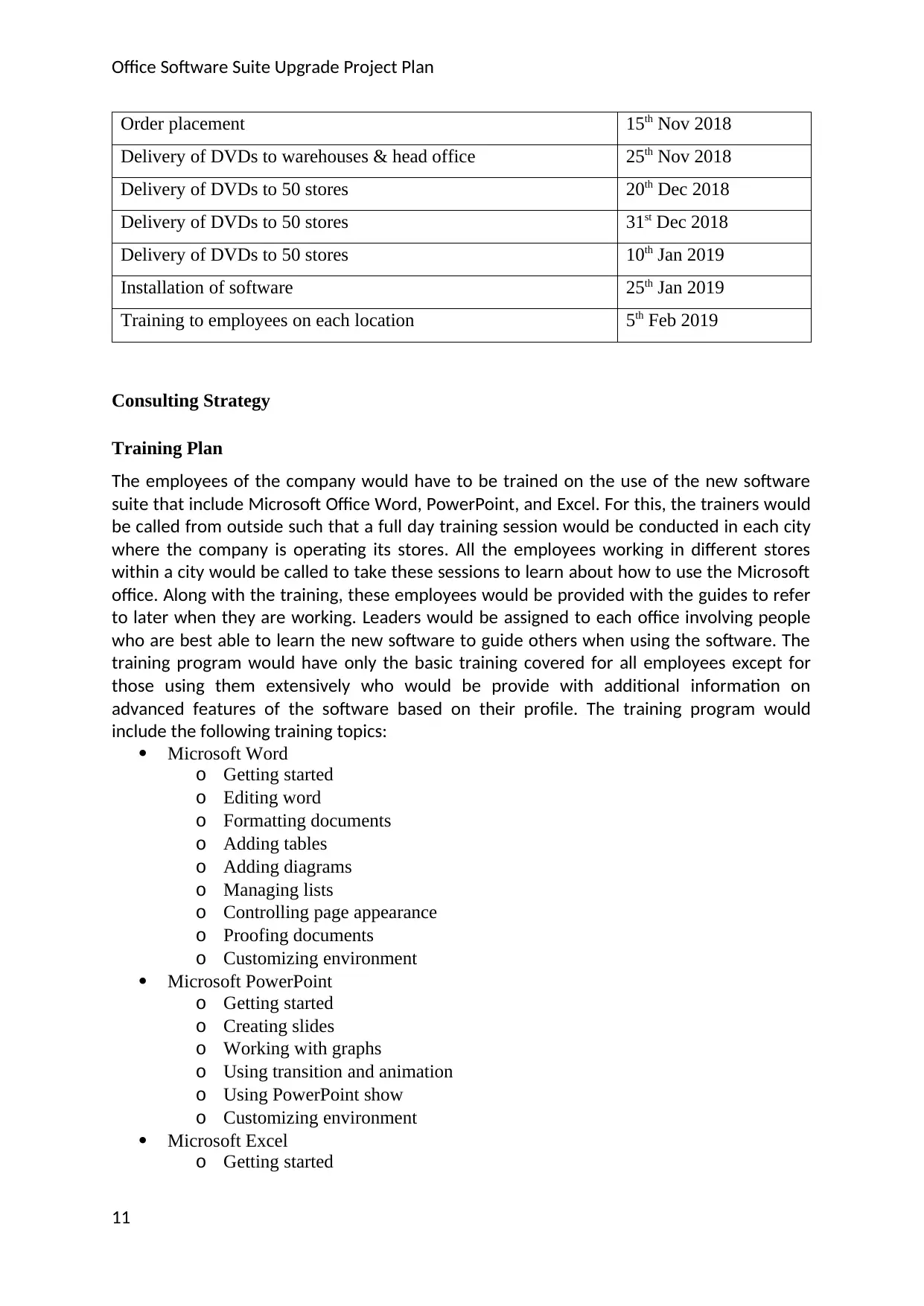
Office Software Suite Upgrade Project Plan
Order placement 15th Nov 2018
Delivery of DVDs to warehouses & head office 25th Nov 2018
Delivery of DVDs to 50 stores 20th Dec 2018
Delivery of DVDs to 50 stores 31st Dec 2018
Delivery of DVDs to 50 stores 10th Jan 2019
Installation of software 25th Jan 2019
Training to employees on each location 5th Feb 2019
Consulting Strategy
Training Plan
The employees of the company would have to be trained on the use of the new software
suite that include Microsoft Office Word, PowerPoint, and Excel. For this, the trainers would
be called from outside such that a full day training session would be conducted in each city
where the company is operating its stores. All the employees working in different stores
within a city would be called to take these sessions to learn about how to use the Microsoft
office. Along with the training, these employees would be provided with the guides to refer
to later when they are working. Leaders would be assigned to each office involving people
who are best able to learn the new software to guide others when using the software. The
training program would have only the basic training covered for all employees except for
those using them extensively who would be provide with additional information on
advanced features of the software based on their profile. The training program would
include the following training topics:
Microsoft Word
o Getting started
o Editing word
o Formatting documents
o Adding tables
o Adding diagrams
o Managing lists
o Controlling page appearance
o Proofing documents
o Customizing environment
Microsoft PowerPoint
o Getting started
o Creating slides
o Working with graphs
o Using transition and animation
o Using PowerPoint show
o Customizing environment
Microsoft Excel
o Getting started
11
Order placement 15th Nov 2018
Delivery of DVDs to warehouses & head office 25th Nov 2018
Delivery of DVDs to 50 stores 20th Dec 2018
Delivery of DVDs to 50 stores 31st Dec 2018
Delivery of DVDs to 50 stores 10th Jan 2019
Installation of software 25th Jan 2019
Training to employees on each location 5th Feb 2019
Consulting Strategy
Training Plan
The employees of the company would have to be trained on the use of the new software
suite that include Microsoft Office Word, PowerPoint, and Excel. For this, the trainers would
be called from outside such that a full day training session would be conducted in each city
where the company is operating its stores. All the employees working in different stores
within a city would be called to take these sessions to learn about how to use the Microsoft
office. Along with the training, these employees would be provided with the guides to refer
to later when they are working. Leaders would be assigned to each office involving people
who are best able to learn the new software to guide others when using the software. The
training program would have only the basic training covered for all employees except for
those using them extensively who would be provide with additional information on
advanced features of the software based on their profile. The training program would
include the following training topics:
Microsoft Word
o Getting started
o Editing word
o Formatting documents
o Adding tables
o Adding diagrams
o Managing lists
o Controlling page appearance
o Proofing documents
o Customizing environment
Microsoft PowerPoint
o Getting started
o Creating slides
o Working with graphs
o Using transition and animation
o Using PowerPoint show
o Customizing environment
Microsoft Excel
o Getting started
11
⊘ This is a preview!⊘
Do you want full access?
Subscribe today to unlock all pages.

Trusted by 1+ million students worldwide
1 out of 17
Related Documents
Your All-in-One AI-Powered Toolkit for Academic Success.
+13062052269
info@desklib.com
Available 24*7 on WhatsApp / Email
![[object Object]](/_next/static/media/star-bottom.7253800d.svg)
Unlock your academic potential
Copyright © 2020–2025 A2Z Services. All Rights Reserved. Developed and managed by ZUCOL.





